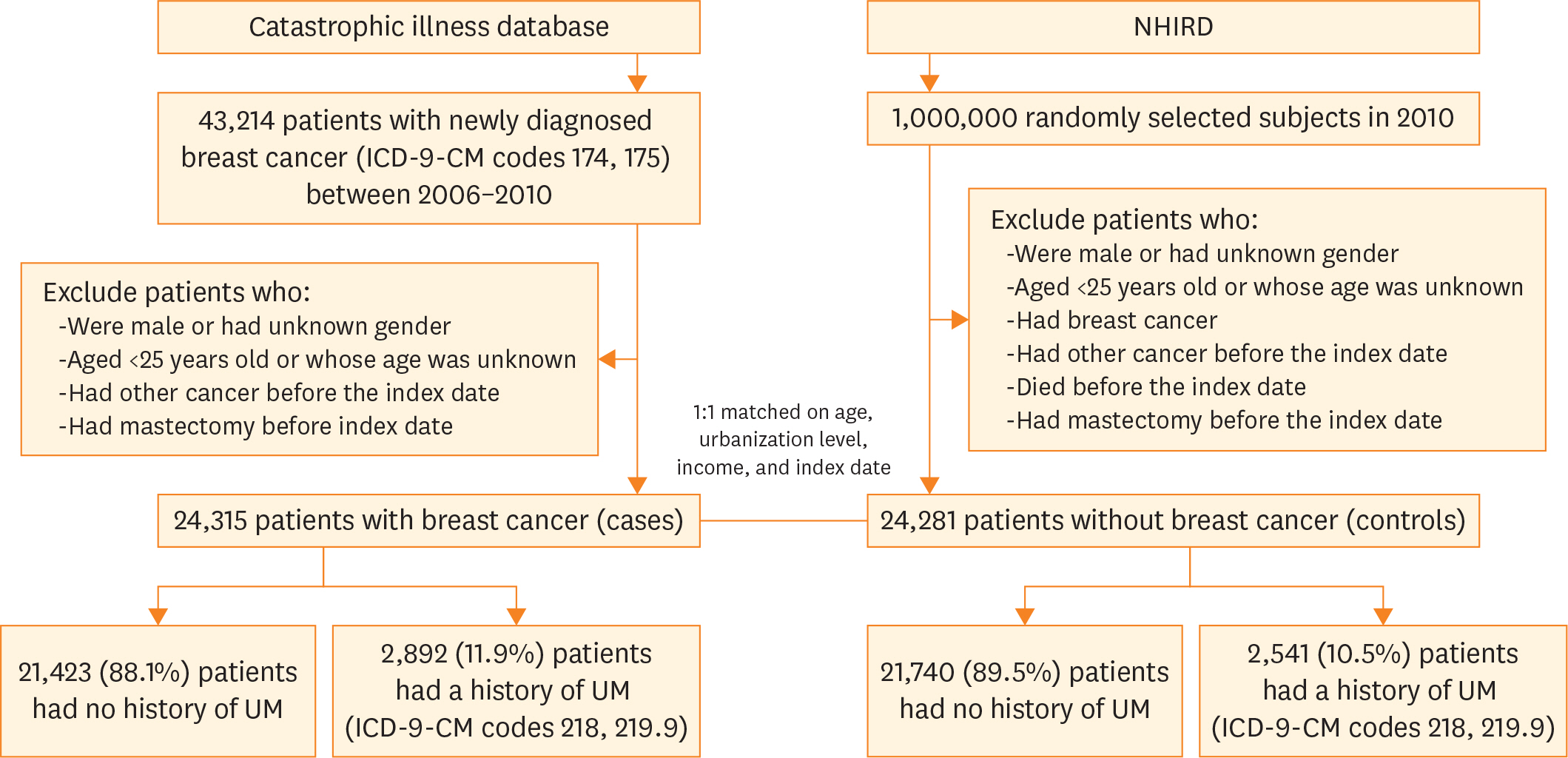J Gynecol Oncol.
2017 May;28(3):e35. 10.3802/jgo.2017.28.e35.
Increased risk of breast cancer in women with uterine myoma: a nationwide, population-based, case-control study
- Affiliations
-
- 1Department of Obstetrics and Gynecology, Taichung Veterans General Hospital, Taichung, Taiwan.
- 2Department of Medical Research, Taichung Veterans General Hospital, Taichung, Taiwan. epid@vghtc.gov.tw
- KMID: 2413446
- DOI: http://doi.org/10.3802/jgo.2017.28.e35
Abstract
OBJECTIVE
To evaluate if uterine myoma is associated with breast cancer.
METHODS
This case-control study used a nationwide database in Taiwan. We identified 24,315 patients with newly diagnosed breast cancer as cases and matched them with 24,281 patients without breast cancer on age, sex, urbanization, income, and initial diagnosis date. Patients with prior mastectomy were excluded. We used logistic regression analysis to assess the association between uterine myoma and breast cancer while adjusting for confounders. We evaluated the impact of surgical removal of uterine myoma on subsequent breast cancer among patients with uterine myoma.
RESULTS
We found that 2,892 (11.9%) patients with newly diagnosed breast cancer and 2,541 (10.5%) patients without breast cancer had a history of uterine myoma. The association between breast cancer and uterine myoma was significant (adjusted odds ratio [aOR]=1.14; 95% confidence interval [CI]=1.07-1.21; p<0.001). This association remained in patients who used hormone (aOR=1.20; 95% CI=1.08-1.33; p=0.001) or who did not use hormone (aOR=1.11; 95% CI=1.03-1.19; p=0.005) within 5 years prior to the index date. Surgical removal of uterine myoma was not associated with a decreased risk of breast cancer (aOR=0.99; 95% CI=0.88-1.10; p=0.795).
CONCLUSION
A minor increased risk of breast cancer was found in women with a history of uterine myoma. This association remained in patients with recent hormone use. Removal of uterine myoma was not associated with decreased risk of breast cancer.
Keyword
MeSH Terms
Figure
Cited by 1 articles
-
Prior uterine myoma and risk of ovarian cancer: a population-based case-control study
Jenn-Jhy Tseng, Chun-Che Huang, Hsiu-Yin Chiang, Yi-Huei Chen, Ching-Heng Lin
J Gynecol Oncol. 2019;30(5):. doi: 10.3802/jgo.2019.30.e72.
Reference
-
References
1. Cramer SF, Patel A. The frequency of uterine leiomyomas. Am J Clin Pathol. 1990; 94:435–8.
Article2. Flake GP, Andersen J, Dixon D. Etiology and pathogenesis of uterine leiomyomas: a review. Environ Health Perspect. 2003; 111:1037–54.
Article3. Parker WH. Etiology, symptomatology, and diagnosis of uterine myomas. Fertil Steril. 2007; 87:725–36.
Article4. Strissel PL, Swiatek J, Oppelt P, Renner SP, Beckmann MW, Strick R. Transcriptional analysis of steroid hormone receptors in smooth muscle uterine leiomyoma tumors of postmenopausal patients. J Steroid Biochem Mol Biol. 2007; 107:42–7.
Article5. Bakas P, Liapis A, Vlahopoulos S, Giner M, Logotheti S, Creatsas G, et al. Estrogen receptor alpha and beta in uterine fibroids: a basis for altered estrogen responsiveness. Fertil Steril. 2008; 90:1878–85.6. Chakravarty D, Srinivasan R, Ghosh S, Rajwanshi A, Gopalan S. Estrogen receptor beta (ERbeta) in endometrial simple hyperplasia and endometrioid carcinoma. Appl Immunohistochem Mol Morphol. 2008; 16:535–42.7. Englund K, Blanck A, Gustavsson I, Lundkvist U, Sjöblom P, Norgren A, et al. Sex steroid receptors in human myometrium and fibroids: changes during the menstrual cycle and gonadotropin-releasing hormone treatment. J Clin Endocrinol Metab. 1998; 83:4092–6.
Article8. Evans JM. An integrative approach to fibroids, endometriosis, and breast cancer prevention. Integr Med. 2008; 7:28–31.9. Leong SP, Shen ZZ, Liu TJ, Agarwal G, Tajima T, Paik NS, et al. Is breast cancer the same disease in Asian and Western countries? World J Surg. 2010; 34:2308–24.
Article10. Health Promotion Administration, Ministry of Health and Welfare (TW). Cancer registry annual report, 2005 [Internet]. Taipei: Health Promotion Administration, Ministry of Health and Welfare; [cited 2015 Jan 21]. Available from:. http://www.hpa.gov.tw/DOWNLOAD/Statistics/.11. Health Promotion Administration, Ministry of Health and Welfare (TW). Cancer registry annual report, 2010 [Internet]. Taipei: Health Promotion Administration, Ministry of Health and Welfare; [cited 2015 Jan 21]. Available from:. http://www.hpa.gov.tw/DOWNLOAD/Statistics/.12. Yen YS, Sun LM, Lin CL, Chang SN, Sung FC, Kao CH. Higher risk for meningioma in women with uterine myoma: a nationwide population-based retrospective cohort study. J Neurosurg. 2014; 120:655–61.
Article13. Lee E, Grutsch J, Persky V, Glick R, Mendes J, Davis F. Association of meningioma with reproductive factors. Int J Cancer. 2006; 119:1152–7.
Article14. Cheng TM. Taiwan's national health insurance system. In: Okma KG, Crivelli L, editors. Six countries, six reform models: the healthcare reform experience of Israel, the Netherlands, New Zealand, Singapore, Switzerland, and Taiwan. Hackensack (NJ): World Scientific;2010. p. 171–204.15. Chen HH, Huang N, Chen YM, Chen TJ, Chou P, Lee YL, et al. Association between a history of periodontitis and the risk of rheumatoid arthritis: a nationwide, population-based, case-control study. Ann Rheum Dis. 2013; 72:1206–11.
Article16. Chuang SC, Wu GJ, Lu YS, Lin CH, Hsiung CA. Association between medical conditions and breast cancer risk in Asians: a national population-based study in Taiwan. PLoS One. 2015; 10:e0143410.17. Wise LA, Radin RG, Rosenberg L, Adams-Campbell L, Palmer JR. History of uterine leiomyomata and incidence of breast cancer. Cancer Causes Control. 2015; 26:1487–93.
Article18. Collaborative Group on Hormonal Factors in Breast Cancer. Breast cancer and breastfeeding: collaborative reanalysis of individual data from 47 epidemiological studies in 30 countries, including 50,302 women with breast cancer and 96,973 women without the disease. Lancet. 2002; 360:187–95.
- Full Text Links
- Actions
-
Cited
- CITED
-
- Close
- Share
- Similar articles
-
- Prior uterine myoma and risk of ovarian cancer: a population-based case-control study
- Risk Factors for Breast Cancer: A Case-Control Study
- Studies on Risk Factors in Cancers of the Breast, Uterine Cervix and Ovary
- Deep Burn Injuries on the Lower Abdomen after HIFU Treatment for Uterine Myoma
- A Case of Bilateral Uterine Arterial Embolization to Treat Uterine Myoma


